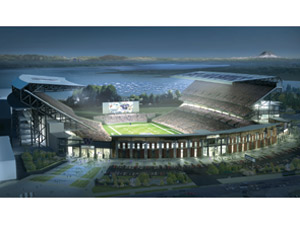Two major stadium renovations at Washington state universities are aiming to attract more fans to college football and boost revenue. A $250-million upgrade at the University of Washington’s Husky Stadium, Seattle, and an estimated $70-million, smaller rehab of Washington State University’s Martin Stadium in Pullman are pitting rival schools against each other in the stadium upgrade race.

Renovations to Husky Stadium, a 90-year-old Seattle icon on the shore of Lake Washington, include the complete demolition and reconstruction of the lower horseshoe bowl and south-side upper stands, added in 1950. A surrounding track will be placed elsewhere on campus and the field lowered four feet to improve sight lines. The upgrade will add a new football operations facility as well as premium seating options, but total seating won’t expand much from the current capacity of 72,500, officials say.
The stadium is the largest footfall facility of any kind in the Northwest and the 15th-largest on-campus structure in the U.S., says the Husky website, but its structural deficiencies pose safety concerns and operational challenges, according to the Husky athletic department.
Jon Runsted, CEO of Seattle developer Wright Runstad & Co., which is heading the renovation, says his company’s bid, awarded in 2010, came in $30 million below the next-lowest bid. The funding model includes no public, state or university contributions. Instead, $50 million will be raised through major gift donations and $200 million through new revenue associated with the stadium. The university will use 30-year bonds to pay for the work. The renovation team also includes 360 Architecture, Kansas City, for design; the Seattle office of New York City-based Turner Construction for construction, and Seattle-based Magnusson Klemencic Associates for structural and civil engineering.
To give crews a three-week head start on construction, work will begin during the season in November 2011. The Huskies will move their final home game and all at-home contests scheduled in 2012 to nearby Qwest Field, the home stadium of the NFL’s Seattle Seahawks. The NFL team played home games at Husky Stadium in 2000 and 2001 during construction of Qwest Field following demolition of the Kingdome. Renovations are set to finish by the start of the Huskies’ 2013 season in September.
At WSU, school officials have issued a request for qualifications seeking architects and engineers for its “football facility improvement program,” says Lawrence Harris, capital planning and development project manager. The Cougars’ project team plans to demolish a portion of the 35,000-seat stadium and replace it with enhanced premium seating, which could add a few thousand seats, he says. Also, work will include a roughly 90,000-sq-ft football operations center as well as upgrades to the scoreboard, lighting and sound system.
In 2008, Martin Stadium underwent a $22.5-million renovation, which included a new main entry fa�ade and concourses. At that time, fundraising began for a third and fourth phase, but new athletic director Bill Moos revamped renovation plans and instead created the improvement program.
WSU expects design development to proceed this spring, with construction set for execution in stages from November through June 2013, if the university’s board of regents approves design and funding models after they are finalized. The Cougars are expected to play at Martin Stadium during renovations.


Post a comment to this article
Report Abusive Comment